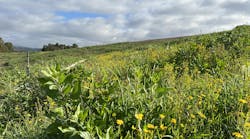Forecast Confirms Uneven Water Supply for West
WASHINGTON, June 18, 2014 — The final water supply forecast for this year shows the West divided into a wet north and dry south while snowpack has already melted in much of the region, according to data from the USDA National Water and Climate Center (NWCC).
Washington, most of Idaho, Montana, Wyoming and the northern parts of Colorado and Utah are expected to have near normal or above normal water supplies through the rest of summer, according to the forecasts. Far below normal streamflows are expected for the southern parts of Oregon and Utah, southwestern Idaho, California, Arizona, New Mexico and western Nevada.
Many of these areas are in the nearly 500 counties across the country experiencing drought, 57 of them in California alone, according to USDA disaster designations.
This year saw near-record low snowfall in parts of Nevada, California, Arizona, New Mexico and the southern parts of Utah and Oregon. Even with some May precipitation, those areas remain dry. The biggest change this season was in the Washington Cascades. At the beginning of February the snowpack was about half of normal, but it recovered and most of Washington will have a near normal water supply from snowmelt, according to the Center.
Spring snowmelt is well underway, according to NWCC hydrologist Cara McCarthy. “A lot of our SNOTEL sites have already melted out, especially those in the southern half of the West,” McCarthy said.
Colorado had mixed weather during May. “They had winter and summer all in one month: snowmelt, snowfall, snowmelt,” said McCarthy. Heavy precipitation combined with snowmelt, causing flooding in parts of the state.
Forecasters monitor conditions all year, but June is the final forecast of the season. “These are snow-based water supply forecasts,” McCarthy said. “Typically by July there won’t be enough snow left on the ground (to measure).”
In Western states where snowmelt accounts for the majority of seasonal water supply, information about snowpack serves as an indicator of future water availability. Streamflow in the West consists largely of accumulated mountain snow that melts and flows into streams as temperatures warm into spring and summer. USDA scientists analyze the snowpack, air temperature, soil moisture and other measurements taken from remote sites to develop the water supply forecasts.
The NWCC water supply forecast is part of several USDA efforts to improve public awareness and mitigate the impacts of climate change, including drought and other extreme weather events. Through the creation of the National Drought Resilience Partnership, launched as part of the President’s Climate Action Plan, federal agencies are working closely with states, tribes and local government to develop a coordinated response to drought.
Since 1939, USDA has conducted snow surveys and issued regular water supply forecasts. View information by state.
Source: USDA



